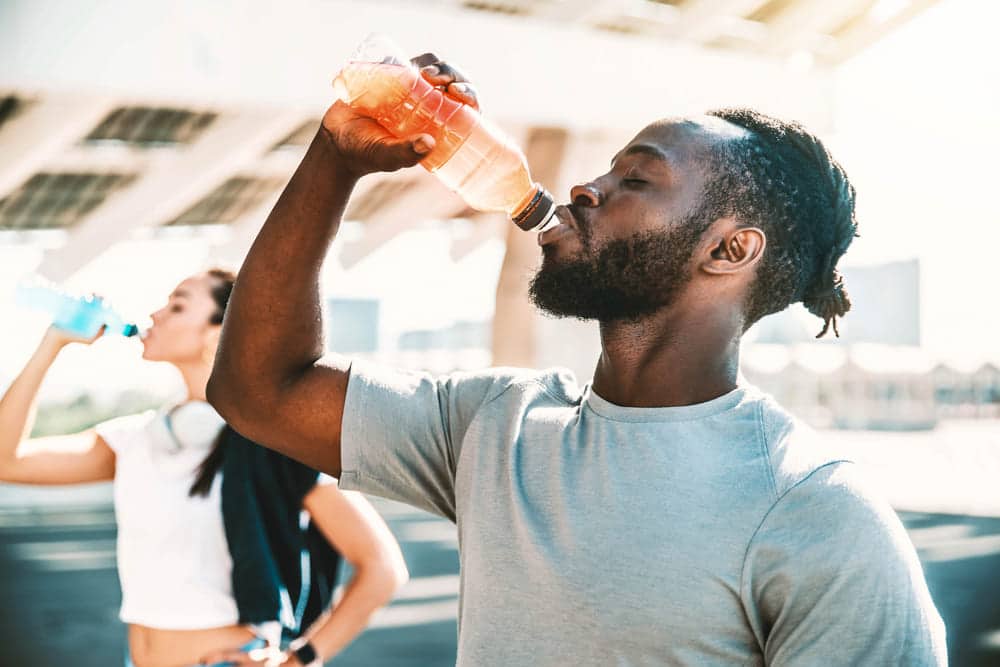Summary
While a few sips of Gatorade are unlikely to seriously harm your dog, it’s generally not recommended as a regular drink.Healthy adult dogs primarily need water for hydration.
Gatorade contains high levels of sugar and sodium, along with artificial ingredients, which aren’t ideal for a dog’s digestive system and can potentially lead to issues like weight gain or electrolyte imbalances with regular consumption.While it does contain electrolytes, dogs don’t lose them in the same way humans do through sweat.
In specific situations like mild dehydration due to vomiting or diarrhea, a veterinarian might suggest small amounts of unflavored Pedialyte (which has lower sugar than Gatorade) or even a homemade electrolyte solution. However, always consult your vet for the best rehydration strategy for your dog. Fresh, clean water is usually the most effective and safest option.
Can Dogs Drink Gatorade?
Yes, dogs can drink Gatorade in moderation, but knowing the potential risks and benefits is important. Gatorade contains electrolytes that can help replenish lost minerals but also contains sugar and other ingredients that can harm dogs in large amounts.
If you give your dog Gatorade, dilute it with water and offer it only in small amounts, such as a few ounces. Avoid giving Gatorade to dogs with diabetes or other health conditions, and always consult with your veterinarian before giving your dog any human food or drink.
What Is Gatorade?
Gatorade is a drink for exercise-enhancement. It has rehydrating electrolytes and also contains a high amount of added sugar. This drink is categorized as a “sports drink.” Experts at the University of Florida formed the drink to increase the football team’s performance in 1965 and named it Gators.
Gatorade is a sports drink with electrolytes to rehydrate humans and supply energy. Nevertheless, it also has high levels of added sugar, which can raise your health risks.
Why Would Anyone Offer Gatorade To A Dog?
As you can see, Gatorade is a human drink that boosts energy and fights against dehydration; dog owners often wonder if offering Gatorade to their dogs is safe. If you notice any sign of dehydration in your dog, you may think of providing Gatorade to your dog. But let me tell you, it is not safe for your dog.
Let’s find out what dehydration dehydration is in dogs and the symptoms, causes, and treatments for dehydration in dogs.
Dehydration In Dogs
Dehydration occurs when the fluid content in the body drops below normal. This usually includes losing both water and electrolytes: sodium, chlorine, and potassium. Dehydration can be caused by a lack of food or water or increased water loss due to illness or injury. Fever increases further fluid loss.
When there is a lack of water in the body, fluid is redistributed from the cells, leaving the cells without sufficient fluid. This leads to dehydration. The degree of dehydration is based on the magnitude of this redistribution of water in the body.
Dogs lose fluid through breathing, stool, urine, and sweating (with shortness of breath, diarrhea, fever, vomiting, water loss increases). Dogs replenish fluids by drinking water or other liquids and eating raw foods.
Causes of Dehydration in Dogs
The dog’s body is designed to drink only what is necessary. On the contrary, your dog’s body always experiences a slight lack of fluid, which does not affect metabolic processes in any way.
Dehydration in a dog occurs when fluid intake decreases. Many reasons cause this condition:
- diarrhea
- fever
- vomit
- burns
- renal failure
- bleeding
- childbirth
- diabetes
- overheat
- heatstroke
- lack of unlimited access to water with a diet consisting only of dry food
- lack of access to food and drink for more than 24 hours
Symptoms Of Dehydration In Dogs?
If your dog is showing any of these signs, it may be something to think about:
- He seems disoriented or woozy.
- Unsteady when walking
- His heart appears to be dashing (the normal heart rate for your dog is between 60 to 140 beats/minute, and the bigger your dog, the slower your dog’s heart rate).
In case you notice any of the above signs, follow these steps to diagnose the issue further:
- Lift your dog’s lips to see your dog’s gums. If your dog’s gums are dry and sticky rather than pink and moist, it’s a sign that the dog requires your attention.
- Examine your dog’s skin properly. Loss of elasticity in the skin around your dog’s neck indicates trouble if you pull on it and it doesn’t recover.
Usually, all it takes to get your dog feeling better is a long break from exercising and a tiny amount of water at a time. Electrolytes in Pedialyte, often found in baby powder and diapers at the shop, will hasten your dog’s recuperation. Pedialyte is appropriate for canines.
Sports drinks and Gatorade are not good for your dog. Ice cubes are another option for feeding your dehydrated dog. You must consult a veterinarian immediately if your dog’s dehydration has become so severe that it prevents them from holding down water. The dog may need intravenous hydration from an expert.
How to Avoid Dehydration In Dogs
Maintaining fluid levels is just as important in dogs as in people.
- Dogs lose a lot of water when they pant. Leave two or three water bowls in different places so your pet gets enough water.
- If your dog has not been able to drink fully for a long time, begin rehydration gradually, allowing the dog a few sips every few minutes. Drinking large amounts of fluid suddenly after a period without water can lead to vomiting, and the dog will lose even more fluid.
- Keep your dog from drinking a lot of water after a strenuous workout.
- Wait a few minutes after your dog’s workout and then allow drinking, often but little by little, every few minutes.
- If your dog shows some signs of dehydration, give him an electrolyte solution.
- Dogs that have gone without water may need help keeping it down. Let them lick the ice so they get the liquid they need.
- If your dog refuses to drink for any extended period, consult your veterinarian!
Treatment of dehydration in dogs
Because dehydration is a life-threatening condition, if you suspect it, you should contact your veterinarian immediately.
Your veterinarian will examine your dog and take the necessary tests to make a diagnosis and identify the cause of the condition. General and biochemical blood tests will help determine the root cause of dehydration.
The hematocrit and total blood protein levels will indicate whether dehydration is present: if they are elevated, dehydration is present. A urinalysis will also help determine if the animal is dehydrated or has kidney damage.
After confirming dehydration, its severity, and its cause, your veterinarian will prescribe appropriate treatment. Dogs with mild dehydration can be treated at home with hydration supervision. Moderate and severe degrees require intravenous administration of drugs to replenish water balance and restore organ function.
How to Prevent Dehydration in Dogs
Prevention is the best medicine when it comes to dehydration. Water should always be brought into the field. I always carry at least one bottle of water for the dog and myself in my luggage. It could be necessary to train your dog to sip from a bottle.
When hunting close to a stream or pond, stop sometimes so your dog can cool off and get a drink. After the hunt, bring a dish of water to the truck so your dog has something to drink.
- Give Your Dog Access To Fresh Water
You must ensure your dog has easy access to fresh, clean water. Also, try to refill your dog’s water bowl regularly and clean the water bowl daily to avoid algae and bacteria growth.
- Check Your Dog’s Water Intake
You always have to monitor your dog’s water intake to understand the possible underlying health issues. If you notice increased or decreased water consumption of your dog, it might suggest that your dog has any health issues. So, you must immediately consult with your vet.
- Offer Ice Cubes
If you notice that your dog is uncomfortable drinking water from a water bowl, you can offer ice cubes as a treat. This way, you can treat your dog and take care of your dog’s dehydration.
- Include Water-Rich Foods In Your Dog’s Diet
If you notice that your dog is constantly refusing water intake and suffering from dehydration, you can include water-rich foods in your dog’s diet.
- Be Aware Of Dehydration Symptoms
To prevent dehydration in your dog, you need to understand whether your dog is truly dehydrated or not. So, look for the dehydration symptoms in your dog, and if you notice any, try any of the methods mentioned above or a few methods to prevent dehydration issues.
Can Dogs Drink Gatorade Safely?
You can offer Gatorade to your dog. However, I do not recommend offering Gatorage to my dog. A few gulps of Gatorade are quite safe for dogs, but water is the best fluid your canine needs to remain hydrated.
Gatorade may help the dog moderately after diarrhea; However, Pedialyte is a better option. Gatorade even has added sodium and sugar, which sabotage any usefulness Gatorade may provide to your dog.
Why Giving Gatorade To Your Dog Is A Bad Idea?
Gatorade has a notable amount of added sugar. Added sugar can be toxic to dogs when consumed in large quantities. Added sugar can irritate your dog’s stomach, and regular, extreme sugar consumption can cause weight gain problems and even obesity.
An obese dog is at high risk of several health issues, such as joint & heart disease and diabetes. Gatorade even has artificial flavors and colors, leading to digestive upset problems or allergic reactions in some canines.
A few sugar-free electrolyte sports drinks have an artificial sweetener named “xylitol.” It is highly poisonous to dogs, and small amounts can lead to liver failure, seizures, low blood sugar, and even death.
Moreover, the electrolyte proportions in Gatorade are prepared for human requirements and might not be suitable for dogs, possibly causing an imbalance in your dog’s system.
What electrolytes can I give my dog?
Electrolytes are essential for maintaining a dog’s fluid balance, nerve function, and overall health. While dogs typically get the electrolytes they need from their regular diet, there are situations where you might need to provide additional electrolytes, such as during illness, dehydration, or intense exercise. Here are some electrolytes that are safe for dogs:
Safe Electrolytes for Dogs
- Sodium (Salt):
- Usage: In very small amounts, sodium is important for fluid balance and nerve function.
- Precaution: Excessive sodium can be harmful, leading to issues like high blood pressure and kidney problems. Always use it sparingly and consult your vet before adding salt to your dog’s diet.
- Potassium:
- Usage: Helps with muscle function, nerve signaling, and fluid balance.
- Sources: Potassium is found in foods like bananas and sweet potatoes. Potassium supplements should only be given under veterinary guidance.
- Calcium:
- Usage: Essential for bone health, muscle function, and nerve transmission.
- Sources: Dogs usually get enough calcium from their regular diet, but it can be found in dairy products and certain supplements if needed.
- Magnesium:
- Usage: Important for muscle and nerve function and enzyme activity.
- Sources: Found in foods like leafy greens and pumpkin seeds. Magnesium supplements should only be given under veterinary supervision.
Commercial Electrolyte Solutions
- Pedialyte:
- Usage: Pedialyte is a popular electrolyte solution for humans that can be safely used for dogs in small amounts. It helps rehydrate and restore electrolyte balance, especially during diarrhea or vomiting.
- Precaution: Choose unflavored Pedialyte without added sugars or artificial sweeteners. Consult your vet for proper dosage.
- Veterinary Electrolyte Solutions:
- Usage: Some pet-specific electrolyte solutions are designed specifically for dogs and may be better than human products. These solutions often come in forms such as powders or liquids.
- Brands: Look for products recommended by veterinarians.
When to Use Electrolytes
- Dehydration: After diarrhea, vomiting, or excessive heat exposure.
- Exercise: During or after prolonged exercise, especially in hot weather.
- Health Issues: When advised by a veterinarian for specific health conditions.
Important Tips
- Consult Your Vet: Before giving any electrolyte supplements or solutions, consult your veterinarian to ensure they are appropriate for your dog’s needs and health conditions.
- Avoid Excess: Too much electrolyte can be harmful, so always use supplements as directed and monitor your dog for any adverse effects.
In conclusion, electrolytes like sodium, potassium, calcium, and magnesium are crucial for maintaining your dog’s health, but they should be administered with caution and under veterinary guidance.


